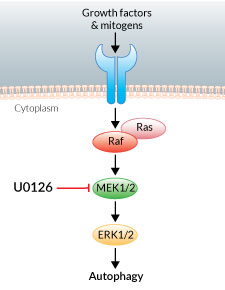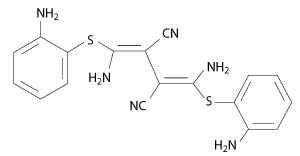U0126
| Product | Unit size | Cat. code | Docs. | Qty. | Price | |
|---|---|---|---|---|---|---|
|
U0126 MEK1 and MEK2 Inhibitor |
Show product |
5 x 5 mg |
tlrl-u0126-5
|
|
MAPK Kinase Inhibitor - Autophagy Inhibitor - MEK1 and MEK2 Inhibitor

MEK1/2 signaling inhibition by U0126
U0126 is a potent and selective inhibitor of MAP kinase kinases, MEK1 and MEK2 [1]. It is widely used as an inhibitor for the Raf/MEK/ERK signaling pathway. This signaling pathway plays a critical role in the regulation of diverse cellular activities, including cell proliferation, differentiation, and survival.
Mode of action:
U0126 acts by inhibiting the kinase activity of MEK1/2 thus preventing the activation of extracellular signal-regulated kinases 1 and 2 (ERK1/2; also called MAP kinases p44 and p42). ERK1/2 activation is central to different cell death programs, such as autophagy and apoptosis [2].
Studies have shown that treatment with U0126 suppresses autophagy [3, 4], as evidenced by reduced levels of Beclin-1 and LC3 and increased p62 expression [3]. Additionally, U0126 has been shown to inhibit apoptosis [3, 4], indicated by reduced caspase-3 activity and the number of TUNEL-positive cells [3].
Key features:
- MEK1 and MEK2 inhibitor
- An autophagy inhibitor
![]() Read our review on Autophagy and Innate Immunity
Read our review on Autophagy and Innate Immunity
References:
1. Favata M.F. et al., 1998. Identification of a novel inhibitor of mitogen-activated protein kinase kinase. J Biol Chem. 273:18623-32.
2. Cagnol S. & Chambard J.C., 2010. ERK and cell death: mechanisms of ERK-induced cell death - apoptosis, autophagy and senescence. FEBS J. 277(1):2-21.
3. Wang A. et al., 2016. U0126 attenuates ischemia/reperfusion-induced apoptosis and autophagy in myocardium through MEK/ERK/EGR-1 pathway. Eur J Pharmacol. 788:280-285.
4. Wang D. et al., 2021. U0126 pretreatment inhibits cisplatin-induced apoptosis and autophagy in HEI-OC1 cells and cochlear hair cells. Toxicol Appl Pharmacol. 415:115447.
Specifications
Working concentration: 10- 50 µM
CAS number: 109511-58-2
Synonym: 1,4-Diamino-2,3-dicyano-1,4-bis(2-aminophenylthio)-butadiene
Molecular weight: 380.5 g/mol
Solubility: 10 mg/ml in DMSO
Quality control:
- Purity ≥ 97% (UHPLC)
- The absence of bacterial contamination (e.g. lipoproteins and endotoxins) has been confirmed using HEK-Blue™ TLR2 and HEK-Blue™ TLR4 cells.
Contents
- 5 x 5 mg of U0126
![]() U0126 is shipped at room temperature.
U0126 is shipped at room temperature.
![]() Upon receipt, store at -20 °C.
Upon receipt, store at -20 °C.
Back to the top
Details
MEK
MEK, also known as Mitogen-activated protein kinase kinase and MAP2K, is a kinase enzyme that phosphorylates mitogen-activated protein kinases (MAPKs), ERK, p38, and JNK. It is a member of the Ras/Raf/MEK/ERK signaling cascade, a central intracellular pathway that is activated by a wide range of growth factors, cytokines, and hormones to promote cell survival, proliferation, growth, and differentiation [1]. Dysregulation of this signaling pathway is involved in many human diseases, such as cancer.
Seven human MEKs have been identified. MEK1 and MEK2 are the prototype members of MEK family proteins. These two isoforms of the kinase operate immediately upstream of ERK, and connect Raf and ERK by phosphorylating ERK. In their kinase catalytic domains, MEK1 and MEK2 are 86% identical, which is why the MEK1/2 inhibitors developed thus far are not selective for either isoform [2]. So far, the only known substrates for MEK1 and MEK2 are ERK1 and ERK2. MEK1 and MEK2 have been extensively researched as targets for novel therapeutics. This research has resulted in significant success to date, including four FDA-approved drugs for use individually or in combination with other therapeutics as cancer therapy [3, 4].
References
1. Dérijard B. et al., 1995. Independent human MAP-kinase signal transduction pathways defined by MEK and MKK isoforms. Science 267(5198):682-5.
2. Frémin C. & Meloche S.., 2010. From basic research to clinical development of MEK1/2 inhibitors for cancer therapy. J Hematol Oncol. 3:8.
3. Akinleye A. et al., 2013. MEK and the inhibitors: from bench to bedside. J Hematol Oncol. 6:27.
4. Han J. et al., 2021, MEK inhibitors for the treatment of non-small cell lung cancer. J Hematol Oncol. 14(1):1.
Chemical structure of U0126





